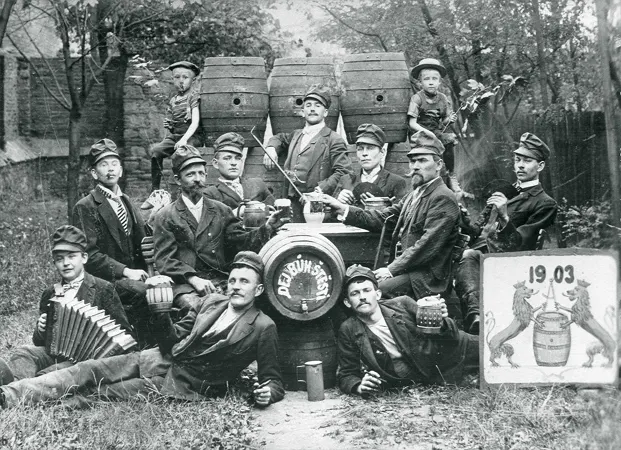Pilsner Urquell, meaning "original source of Pilsner" in Czech, was the first Pilsner style beer.
Pilsner Urquell is a Bohemian Pilsner-style lager beer that is brewed by the Plzeňský Prazdroj brewery in Plzeň (Pilsen)
This beer gained popularity worldwide due to its clear golden color, delicate hop bitterness, and crisp finish, which was a stark contrast to the darker and heavier beers that were popular at the time.
Pilsner Urquell's success sparked a trend of Pilsner style beers being brewed around the world, leading to the widespread popularity of this beer style.
This success worked against the brewery as the beer's burgeoning popularity led to numerous imitators, and to finally protect its brand, the Plzeňský Prazdroj brewery trademarked the name "Pilsner Urquell" in 1898 (they had trade mark laws back then? - Ed).
So, now we know how pilsner-style beers got started, but what is the style exactly?
It is a pale lager that is known for its light and crisp taste, with a golden color and a clear appearance.The defining characteristics of a Pilsner style beer are its delicate bitterness from the use of noble hops and its refreshing finish. Pilsners are usually well-carbonated and have a moderate alcohol content, typically ranging from 4-5% ABV.
They are light in body, and have a dry finish, making them a popular choice for beer drinkers who prefer a refreshing beer that is easy to drink.
What are the 'noble hops' commonly used in pilsner beers?
Noble hops are a group of four hops varieties that are widely considered to be the classic hop varieties for brewing traditional European-style beers, including Pilsner.The four noble hop varieties are:
- Hallertauer Mittelfrüh: grown in Germany, it imparts a mild, spicy flavor and aroma.
- Saaz: grown in the Czech Republic, it is known for its mild, earthy and herbal character.
- Tettnang: grown in Germany, it has a spicy and floral aroma.
- Spalt: grown in Germany, it has a floral and spicy character.
Think of these 4 as like the 4 Grand Slam events on the ATP Tennis Tour...
What malts are used in pilsner beers?
Pilsner style beers are typically made using a base malt of Pilsner malt (two-row spring barley), which is a pale, lightly kilned malt. This malt provides a light, crisp and delicate malt flavor, as well as a light golden color, that is characteristic of Pilsner-style beers.
Other malts, such as Munich malt, may also be used in small quantities to add depth and complexity to the malt profile.
In general, the malt bill for a Pilsner style beer is designed to be simple and straightforward, allowing the hops to be the dominant flavor and aroma component. The goal of the pilsner style is to create a clean and refreshing beer with a light malt character, balanced by the delicate hop bitterness and aroma.
It's worth noting that the exact malt bill can vary between breweries and different Pilsner style beers, but the use of Pilsner malt as the base malt is a common characteristic of this style of beer.
Here's a list of some world famous pilsner style beers:
- Samuel Adams Boston Lager - Originated in the United States, this beer has a rich and robust malt flavor with a hoppy balance and a clean finish.
- Warsteiner Premium Verum - Originated in Germany, this beer is known for its crisp, clean and refreshing taste with a mild hop bitterness.
- Heineken - Originated in the Netherlands, this beer is known for its light, crisp and refreshing taste, with a delicate balance of hops and malts.
- Stella Artois - Originated in Belgium, this beer has a smooth and well-balanced flavor profile with a mild hop bitterness and a crisp finish.
- Pilsner Bier - Had its beginnings in Switzerland, this beer is known for its bright and crisp taste, with a moderate hop bitterness and a clean finish.
- Budweiser Budvar - Sprang from the Czech Republic, this beer is known for its rich malt flavor, with a balanced hop bitterness and a crisp finish.
- Bitburger Premium Pils - Began in Germany, this beer is known for its crisp and refreshing taste, with a moderate hop bitterness and a dry finish.
What kind of meals match well with a pilsner?
Some common food pairings with Pilsner include:- Seafood: The light and crisp flavors of Pilsner are a perfect match for seafood dishes such as grilled fish, shrimp, and oysters.
- Spicy food: Pilsner's crisp and refreshing character can help to balance the heat in spicy dishes such as Thai, Mexican, and Indian cuisine.
- Salad and lighter fare: The light and refreshing flavor of Pilsner is a great match for lighter fare such as salads, vegetables, and cheese plates.
- Fried and fatty foods: Pilsner's crisp and refreshing character can help to cleanse the palate between bites of fried and fatty foods such as fried chicken and burgers.
- Barbecue: The clean and crisp flavors of Pilsner can help to balance the rich, smoky flavors of barbecue dishes.
What is the best type of glass to drink a pilsner from?
Glass types matter for drinking beer so it's worth checking what a good bartender will serve his cold beverages in.
Pilsner glasses typically hold around 10-15 ounces of beer, making them the perfect size for a standard pour of a Pilsner style beer. The design of the glass also helps to maintain a beer's head, which is important for preserving its aroma and flavor.

0 comments:
Post a Comment